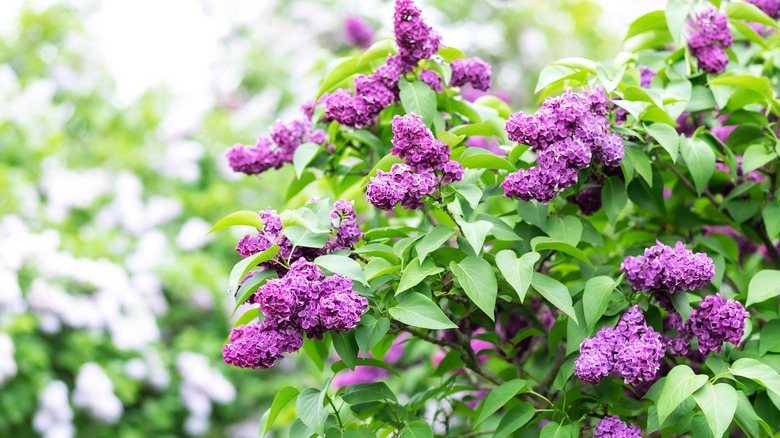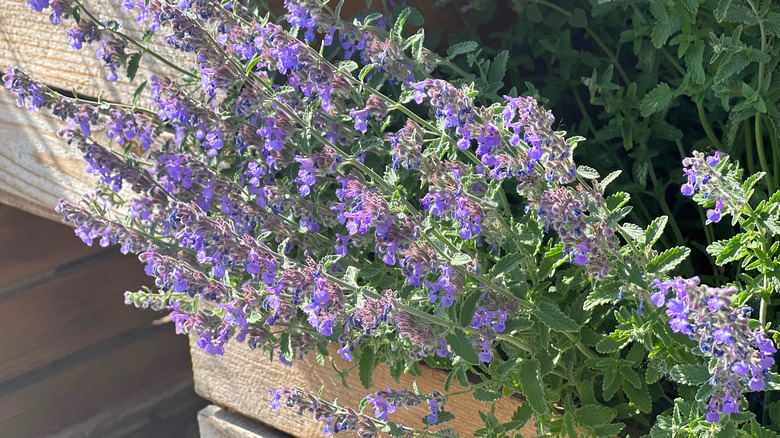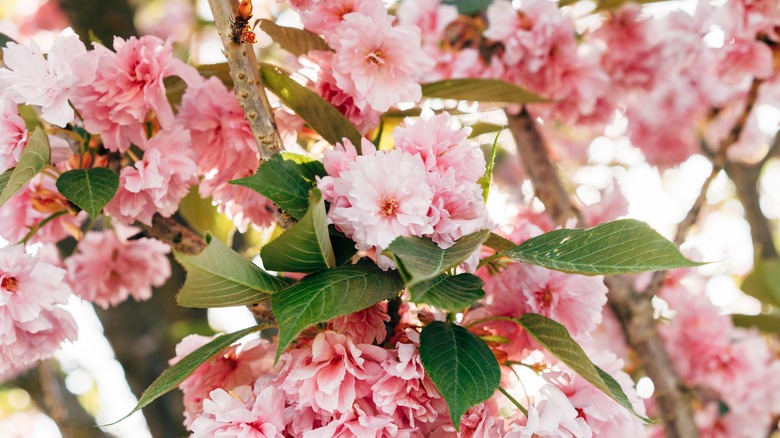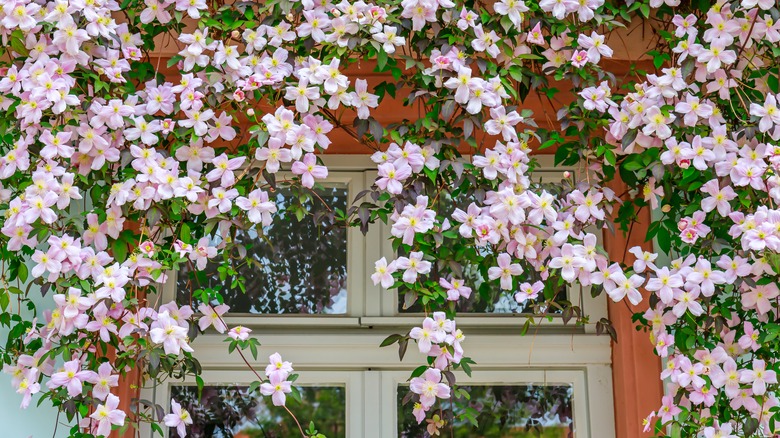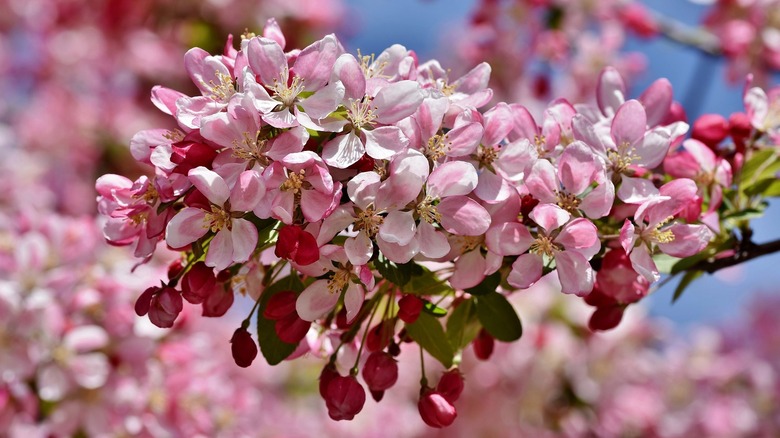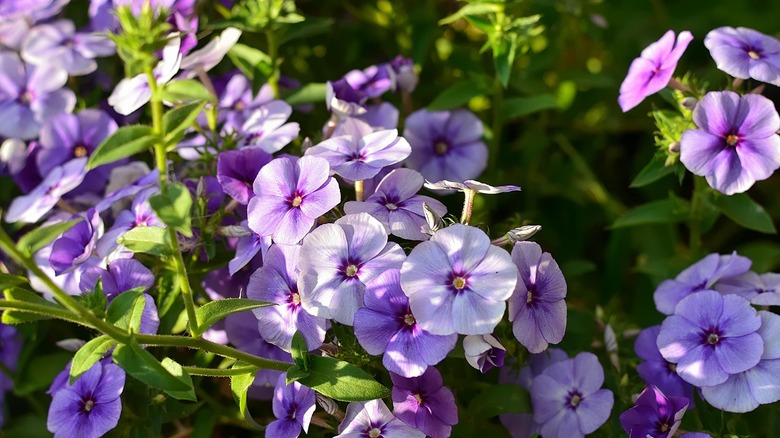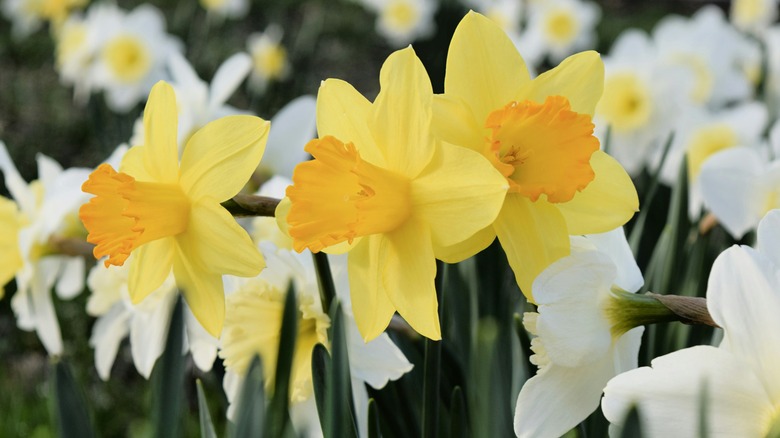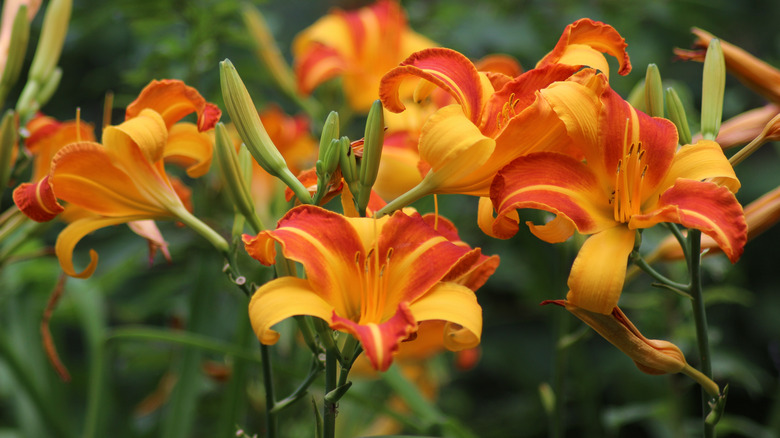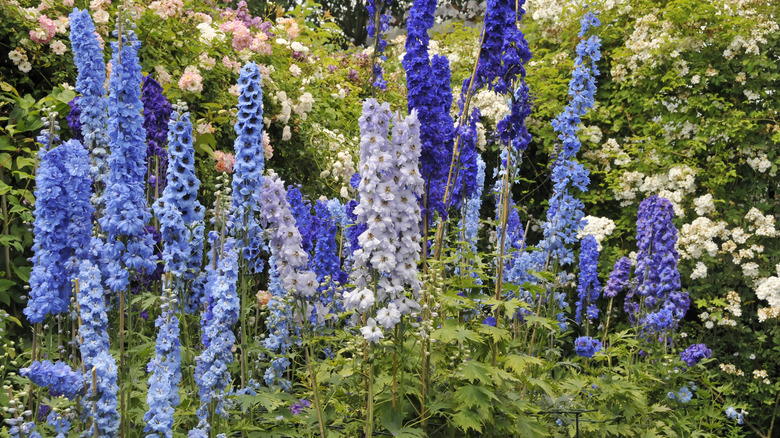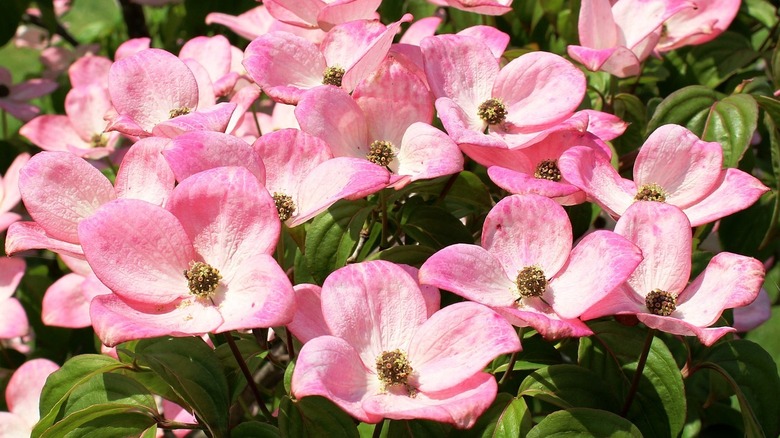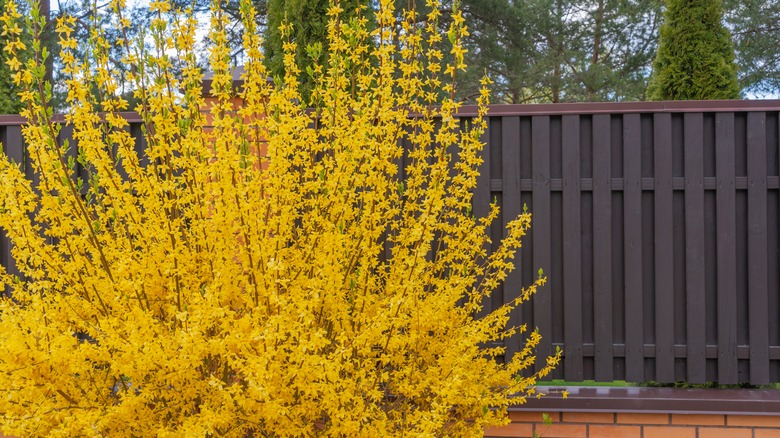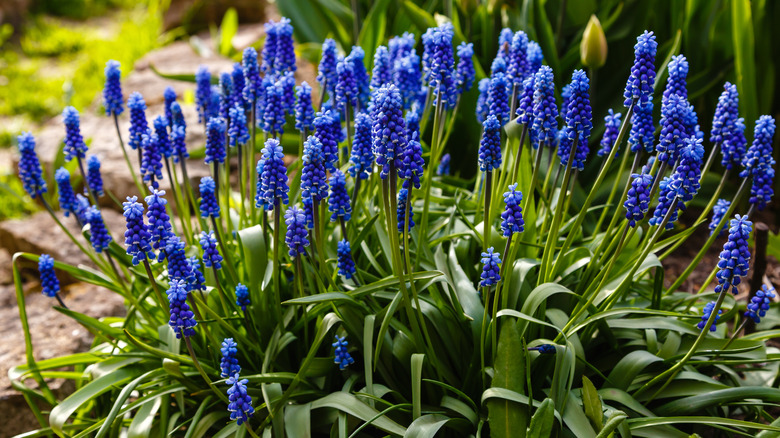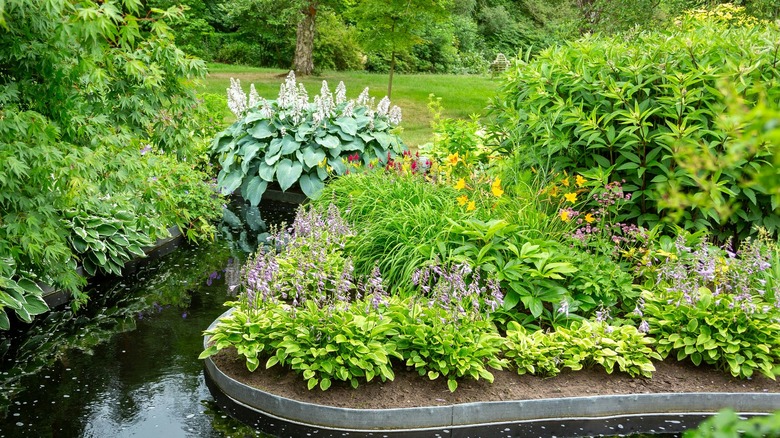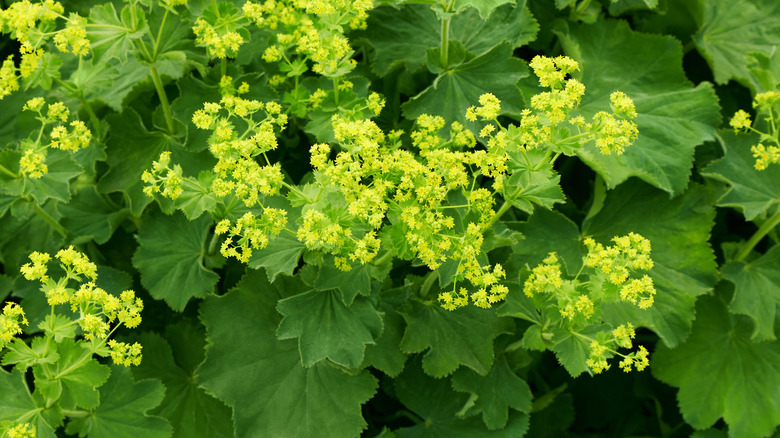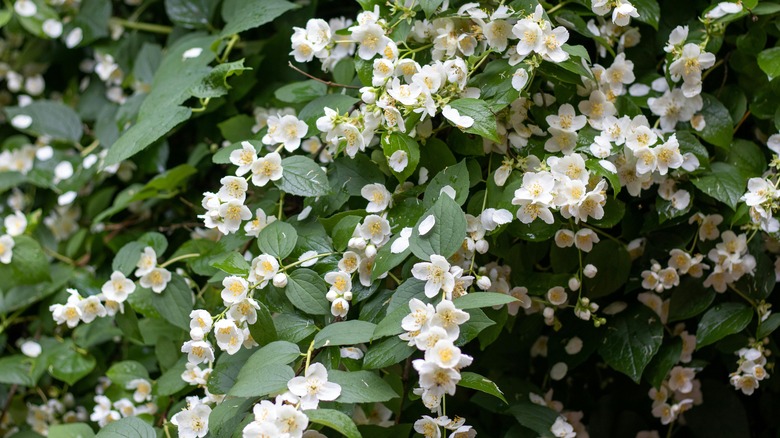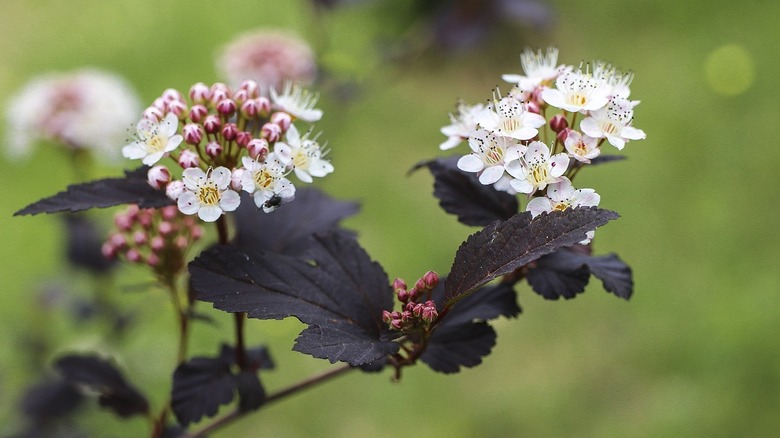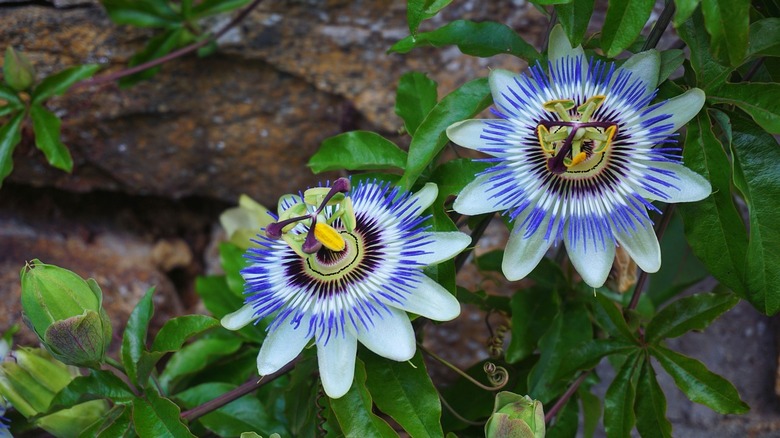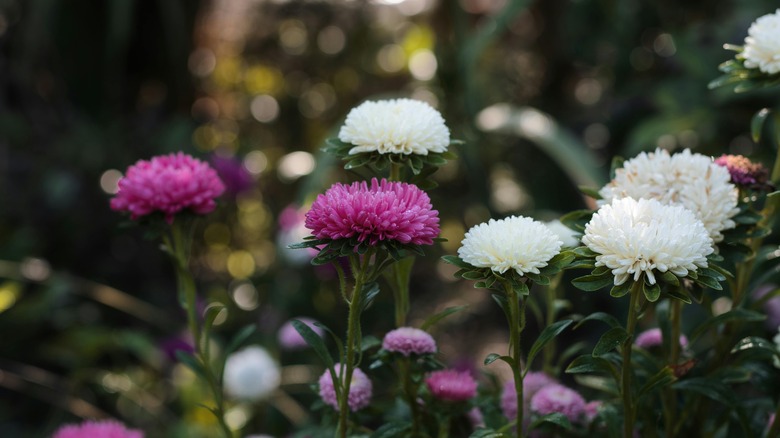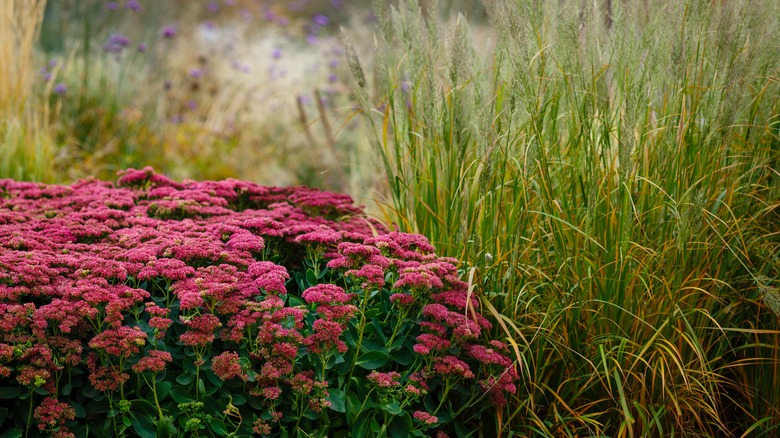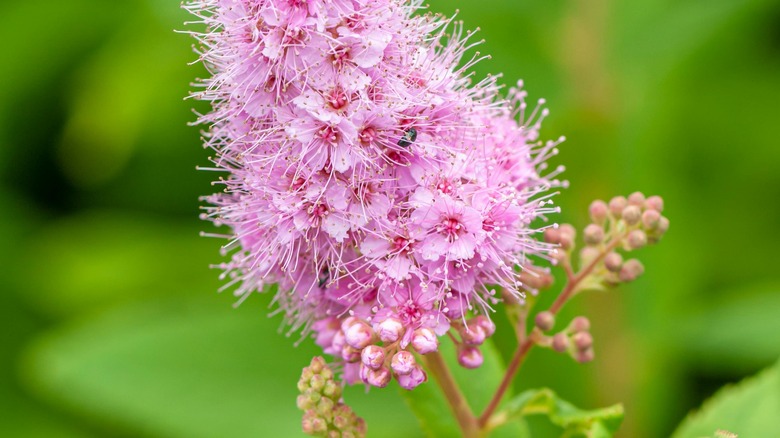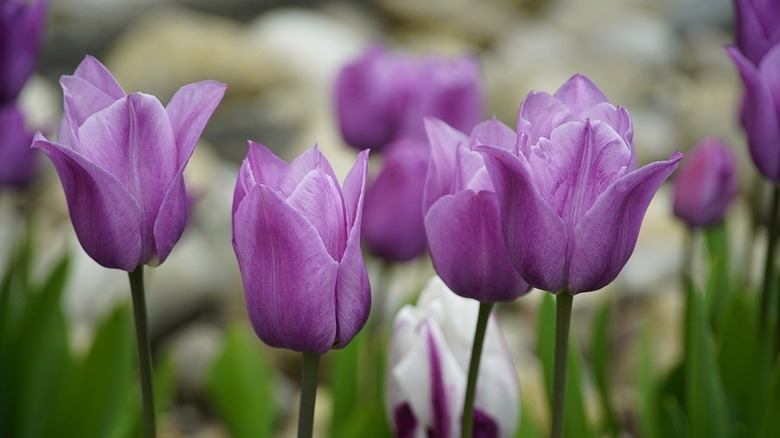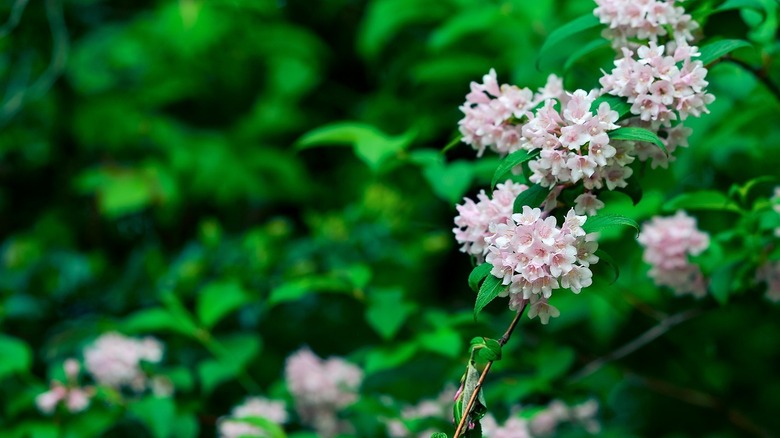21 Companion Plants You'll Want Next To Your Fragrant Lilacs This Year
Lilacs, also known as Syringa vulgaris, are deciduous shrubs that add a vibrant splash of purple to landscapes in colder climates. There are many climbers, creepers, herbs, shrubs, and trees that make excellent companions for this species. They thrive in similar conditions and many flower at opportune times alongside growing lilacs. These plants tolerate some shade but prefer full sun throughout the day and well-draining humus-rich soil. USDA growing zones 3 to 7 are ideal for them to flourish and bloom, and you can expect their flowers from late April to early June.
Lilac petals range from white to different shades of purple, and they're known for being just as fragrant as they are beautiful, making them great front liners in ornamental flower gardens. Below are 21 plant species that prefer climates and conditions similar to this deciduous shrub. Each species complements lilacs aesthetically without competing for nutrients and sunlight.
1. Catmints have similar tubular and pastel purple flowers
Catmint, or Nepeta cataria, is an herb that is more ornamental than aromatic. It looks very similar to lilacs, having the same pastel purple coloring and lush green stems. It only grows 1 to 3 feet tall, so keep it on the outer edges of lilac gardens where it isn't overshadowed. Catmint thrives in full sunlight and needs little caretaking once it reaches maturity. You can plant catmint in the fall, the same way you would with lilacs, as long as there's no danger of frost.
2. Cherry trees bloom light pink flowers at the same time
If you live in hardiness zones between 3 and 7, you can add flowering cherries to your lilac garden. Also known as Prunus accolade, these trees grow between 8 to 18 feet, depending on whether you choose the dwarf or semi-dwarf variety. Their most remarkable feature is sporting beautiful shell-shaped flowers during springtime. They prefer full sun in well-draining soil, making these flowers great companions for pastel-colored lilacs. They are low-maintenance and bloom around the same time as their neighbors, making for an excellent display for up to three weeks.
3. Clematis flowers blossom after lilac petals have dropped
Another flower with a rich purple coloring is the clematis or Clematis viticella. This flower also sports bright pink flowers, depending on the variety, and often blooms in the late springtime. Its growth cycle maintains a colorful garden after lilac flowers have dropped for the season. Avoid using them if you live in USDA zone 3, but zones 4 through 11 are perfectly ideal. With their preference for sun and moist but well-draining soil, they make excellent companion plants for common lilacs.
4. Crabapple trees are vibrant throughout the year
Crabapples are trees that tower over flower gardens and have vibrant colors throughout the year, creating a vivid landscape even when lilacs aren't in their flowering season. They come in various colors, including white, pink, and red flowers. Their leaves also range from a bronze color to dark green, and even their fruits come in various shades. These colorful trees add height to lilac flower gardens in USDA growing zones 4 to 7. They are fairly resilient and adapt to different soil conditions, making them relatively easy to raise.
5. Creeping phlox thrive in the shade of tall flowering shrubs
You can grow creeping phlox in zones 5 through 7 alongside lilac. These plants enjoy full sun but tolerate dappled light, making them fine to grow in the cover of tall flowering herbs. Smelling like cloves and vanilla, their red, purple, or blue flowers add decorative and fragrant elements to a landscape. Just make sure you plant the right variety, which is Phlox stolonifera. The Phlox subulata strongly resembles the Phlox stolonifera but is a moss-like version that emits a musky smell similar to cannabis.
6. Daffodil varieties bloom during and after lilac season
Daffodils (Narcissus) come in many cultivars, most of them sporting a white or yellow color but with different-shaped petals. The flowers bloom at different times in the spring and summer, so grow many types of cultivars to get multiple flowering times. They grow on a long green stalk and prefer hardiness zones 3 through 9. Although they thrive in full sun, daffodils prefer soil slightly more acidic than lilacs do and don't like being crowded, so they do best on the outer edges of your lilac garden.
7. Daylilies are small but bold additions to lilac gardens
Daylilies, or Hemerocallis, are known for their adaptability in most conditions in zones 4 to 9, making them great options for many locations. They blossom throughout late summer, producing hundreds of flowers in a single season. They bloom and drop petals daily, meaning these flowers need lots of nutrients to support their vigorous growing cycle. They come in many shades: white, light pink, orange, red, and almost black. Their colors mesh well with lilacs, though you should plant them 18 inches apart from other plants so they have room to spread out.
8. Delphiniums thrive in identical conditions as lilacs
With a preference for alkaline soil and full sun, delphiniums thrive in the same hardiness zones as lilacs. These summertime flowers bloom in pastel blues, pinks, and purples, and some varieties even sport white flowers. The name "delphinium" is derived from the Greek word for dolphin due to the flower's shape, which resembles the jumping marine creature. It has a similar look to lilac, making it the perfect companion to this shrub. Not only do the growing conditions match, but so does the vibrant flowering pattern.
9. Dogwood has colorful flowers and leaves that complement lilac
Another tree you can plant alongside this flowering shrub is the dogwood or Cornus florida. It sports cross-shaped showers in green, pink, yellow, and white hues and complements lilac flowers in hardiness zones 5 through 7. With its preference for full sun and moist, well-draining soil, this plant enjoys the same conditions as its recommended companion. In addition to its bright flowers, this tree species' leaves turn gold, red, and purple in the fall, making it a colorful stunner in an ornamental landscape.
10. Forsythia adds a splash of yellow to lilac gardens
The flower shrub forsythia belongs to the same olive family as lilacs, giving them very similar preferences. Unlike many of the flowering species on this list, forsythia flowers aren't the same pastel pink and purple shades as lilacs; rather, they are deep yellow to green colors. Both plants attract pollinating insects, which helps them reproduce and thrive during growing seasons. Keep in mind that forsythia does prefer climates slightly warmer than lilacs, and you should only put the plants together in zones 5, 6, and 7.
11. Grape hyacinths are the bell-shaped sister of lilac
Grape hyacinths, Muscari armeniacum, produce flowers in a deep cobalt color just as the name implies. They thrive in the same zones as lilacs, producing tall bell-shaped flowers and grass-like leaves. They bloom at the first sign of spring, die back, and start growing again in mid to late fall. These odd but persistent growing patterns add color to gardens while the lilac is out of commission. This particular cultivar is also known for its mildly grassy but fruity scent, which also alludes to its namesake.
12. Hostas thrive in the dappled shade of taller shrubs and trees
Unlike many flowering plants, hostas are better known for their exquisite leaves than anything else. These perennials are less commonly known as plantain lilies and blossom in the same zones as lilacs, enjoying the same well-draining and nutrient-rich soil. Make sure you plant a darker variety unless your hostas are shaded by nearby plants — darker leaves are more tolerant of full sunlight. Although their variegated leaves come in many colors and shapes, this plant also sports fragrant white, lavender, and purple flowers.
13. Lady's mantle complements with greenery and dainty floral accents
Alchemilla mollis, better known as lady's mantle, are low-growing plants that are great for covering the leggy undergrowth of lilacs. They thrive in all the same hardiness zones as lilacs, except for zone 2, and enjoy the same lighting and soil conditions. These plants work best as a ground cover or border pieces in gardens, with their small yellow and light green bunches of flowers. They bloom in late summer, adding subtle coloring to your garden when lilacs are already gone for the year.
14. Mock orange shrubs contrast well as a lilac backdrop
Mock orange shrubs are often grouped alongside lilacs and forsythia, making the three common combinations in floral gardens. These shrubs are also known as the "Lewis' mock orange" and Philadelphus lewisii, and they are especially notable for their strong fragrance. They fill the air with the scent of citrus blossoms during early summer. When combined with lilac, landscapes emit an unmistakable springtime scent. It helps that these plants also prefer USDA zones 4 through 8 with many of the same conditions required for lilac survival.
15. Ninebark bushes grow well alongside other flowering shrubs
Ninebarks are incredibly resilient and flexible shrubs that grow in the same hardiness zones as lilacs. Although these plants only flower in the spring with white and pink blooms, they add aesthetic appeal year-round with their unique mounded shape and shedding red-colored bark. Since these plants are tolerable to most conditions, they easily grow alongside lilac, adding a gorgeous dark backdrop to the vivid purple petals. Conveniently, ninebarks' dark foliage and bark also looks beautiful alongside other popular companion plants to lilac, enhancing its appeal to landscapes.
16. Passionflower vines bloom in vivid colors like lilacs
Few flowers can compete with the otherworldly beauty of the passionflower vine; the petals bloom in shades of blue, pink, and purple with multicolored green and yellow pistils. They are picky about their climate needs and are only suitable companions for lilacs in USDA zone 7. If you're lucky enough to live in this narrow stretch through the middle of the United States, the dense foliage of passionflower vines masks the leggy bottoms of lilacs, making your garden appear lush and healthy.
17. Peonies have a complementary fragrance and aesthetic
Peonies and lilacs look beautiful together in bouquets since peonies' puff shape and lilacs' tubular shape create a contrasting but complementary appearance. They grow well together in USDA zones 3 through 7. Peonies, or the Paeonia genus, include over 33 species of fragrant flowers in shades of white, pink, red, and yellow. The blossoms slightly differ having fuller or thinner pistil centers. Although all the flowers are beautiful alongside lilac, you may want to avoid double-flowered cultivars, as these species of peonies often require staking to hold up their heavy blooms.
18. Sedums bloom into late fall when lilacs go dormant
The "Autumn Joy" cultivar of sedum (Hylotelephium spectabile) plants are pretty perennials that add bright red and pink flowers during the late summer when lilac plants are mostly made of leaves and branches. Thriving in zones 3 to 9, these plants' star-shaped flowers often hold up through the fall. In fact, the blooms darken into winter, creating a transitioning landscape during later seasons. The main perks of these plants are that they don't require much maintenance, and you don't need to deadhead them during the wintertime.
19. Dwarf spireas repeatedly flower outside of lilac season
Dwarf spirea are another shrub that thrives well in full sun conditions throughout zones 3 to 9. Spirea plants grow in dense clusters and can grow to be 10 feet tall, so it's safer to grow the dwarf variety and make sure that they don't provide unwanted shade for lilac and its other full-sun-preferring neighbors. They typically start blooming after lilacs but repeatedly flower until September when they prepare to go dormant alongside other perennial plants. They aren't too fussy when it comes to soil and watering.
20. Tulips add color to gardens during lilac's off-season
The 100 species of tulips come with various characteristics. They are among the most popular flowers, and with the right sunlight, watering routine, and soil, many varieties grow throughout the United States. Up north, where lilacs are commonly found, tulips enjoy full sun and rich, well-draining soil, just like their potential counterparts. Each bulb produces a single flower, which can be white, yellow, orange, pink, red, and even motleys of multiple shades. Certain varieties have a floral scent that melds pleasantly with lilac, such as "Ad Rem" and "Mount Tacoma" tulips.
21. Weigala shrubs share the same qualities and growing needs as lilac
Weigela is another flowering shrub that does well alongside lilacs. It thrives best in USDA zones 4 through 8 and prefers direct sunlight throughout the day. The flowers range between red, pink, white, and yellow, and the leaves are green, yellow, and sometimes variegated with purple or black. Such vibrant color schemes enhance lilac gardens, especially during the spring when flowers are in bloom. Weigelas are also known to exude a sweet fragrance that attracts coveted wildlife, like butterflies and hummingbirds.
